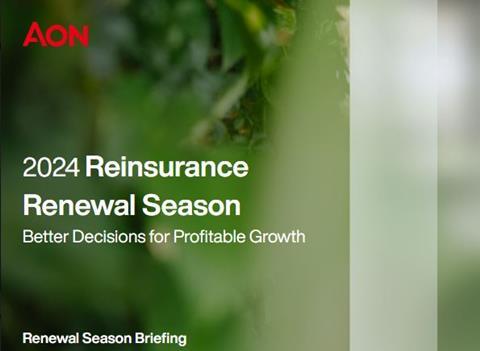Led by Andy Marcell led a senior leadership panel to discuss global reinsurance market dynamics as the industry heads to the Monte Carlo RVS 2024.

Reinsurers are looking to maintain profitable growth and minimise the impact of retained volatility experienced through US reserve development, climate change and secondary perils
This has been a leading topic of conversation with the primary market insurers that retain much of this risk, noted Andy Marcell, Aon’s CEO of risk capital and CEO of its ‘Reinsurance Solutions’ arm.
Aon is focused on “the need to rebalance of that” and looking for “reinsurers to afford them some sideways protection”, Marcell suggested in his opening remarks.
He was speaking at Aon’s virtual pre Monte Carlo briefing for the 2024 reinsurance renewal season.
Ahead of targets
Reinsurers have been growing “more through rate on existing business, rather than through new exposure”, noted Aon’s head of business intelligence, reinsurance, Mike Van Slooten.
“We see combined ratios averaging around 90%, suggesting significant margin in the business as it is structured today,” he said.
Reinsurers’ investment returns were likely to continue to do well, Van Slooten said, while average return on equity (ROE) was “close to 20%…“well ahead of most stated targets, and the primary market”, he noted.
In fact, these are some of the best results the reinsurance sector has ever produced. Importantly, strong earnings have enabled reinsurers to boost reward to investors – payback, if you like, for the difficult experiences in the 2017-2022 period,” Van Slooten added.
Enough has been retained to boost Aon’s global reinsurer capital calculation to a new high of $625bn, he revealed.
“The question then becomes: ‘What is going to be done with all the new capital that’s being generated?’ And we have a clear answer: ‘Work with us to help our clients overcome the increasing complexity of risk that we see in today’s marketplace,’” Van Slooten said.
He stated some of the challenges facing primary market insurers.
“Insured losses from secondary perils are continuing at record levels, and the bulk of these losses are now being retained by the primary market. Based on the latest data, it looks like 2024 will be another $100bn loss year, irrespective of what happens in the remainder of Atlantic hurricane season,” Van Slooten said.
“On the casualty side, litigation funding, adverse legal environments and emerging risks are creating significant uncertainty around ultimate loss costs. Finally, as well as the trauma of local conflicts, heightened geopolitical risk is bringing interconnected supply chains, resource dependency, and cyber aggregations into focus,” he continued.
“In short, withdrawal from risk is not the answer. Helping to manage risk is the business we are all in. We therefore call on the reinsurance community to lean into these challenges and work with us to help build a more sustainable and relevant insurance marketplace,” Van Slooten added.
Alternative capital has reached an estimated new high of $110bn, driven by new inflows of catastrophe bonds.
He pointed to parametric solutions, cyber risks and partnerships with government agencies as areas of growth potential.
Capital was also mobilising through new managing general agents (MGAs), he added, representing “a great example of the market reacting to growing client need for broader access to capital”.
Property dynamics
Tracy Hatlestad, Aon’s global property leader for reinsurance, had five main points to make.
The first was that “capacity is robust for property catastrophe risk”, despite a lack of new reinsurer entrants to the market, increased rates, retentions and reinsurer earnings.
New Balance Sheet entrance not coming to the market, increased rates and retentions of the last few years, as well as reinsurer earnings.
She cited a circa 10% increase in demand of the property cat market being “well met by supply from reinsurers and the cat bond on community in particular”.
An eased inflation trend meant she expected demand will continue to increase in 2025, but at a slower rate than 2024 “likely circa sub 5% to 5%”, she suggested.
Softening of rates was expected, she said, but reinsurers’ earnings would still meet ROE expectations.
She said it was important “not to forget the activity of the 2017-2022 period”, but also added that this and the years before it also “promoted a really strong, balanced relationship with reinsurers and their cedants, and we’re looking to have that happen again in 2025”.
Thirdly, the market will continue to be competitive for cat risks, she said, expecting reinsurers to come to market “with a partnership minded approach” and a holistic approach to other placements, emphasising individual cedants’ differentiation.
Fourthly, she stated that the market “could do more” to provide frequency protection for cedants, after the primary market had retained “the vast majority” of recent loss activity, more than half of which had come from cat losses other than hurricanes and earthquakes – led by severe convective storms.
“As a market, we expect that reinsurers will have capital to put to use to protect against the volatility of this risk,” Hatlestad said.
Lastly, she emphasised that renewals would “continue to be competitively priced”.
She said insurers would have “high expectations” for reinsurers meeting deadlines for quoting and “clean authorisations in a consistent manner”.
“Responsiveness to individual cedant priorities will be a key indicator to insurers of the level of commitment that a reinsurer brings to the renewal process, and will be a strong decision metric on final line assignments across renewals,” she added.










No comments yet